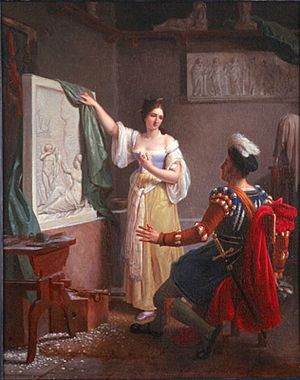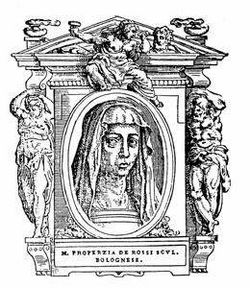Properzia de' Rossi facts for kids
Properzia de' Rossi (c. 1490 Bologna – 1530 Bologna) was a ground-breaking female Italian Renaissance sculptor, the only woman to receive a biography in Vasari's Lives of the Artists. According to Vasari, she taught herself to carve by working with peach-stones. At the end of her life, she was sought out by the Pope Clement VII, however, she died while he was on his way to meet her.
Contents
Biography
Properzia de' Rossi was born in Bologna; she was the daughter of a notary named Giovanni Martino Rossi da Modena. Unusually for early modern female artists, she was not the daughter of an artist. She appears to have studied painting, music, dance, poetry, and classical literature. She is also said to have studied with a sculptor at the University of Bologna. Vasari stated she was expert in "household matters" as well as many sciences and played and sang "better than any other woman of her city". Undecided in her youth as to which outlet of self-expression she wanted to pursue, she found her direction when she tried her hand at sculpture, creating small but intricately detailed works of art on apricot, peach, and cherry stones according to some sources, though this may have been a fabrication by Vasari meant to explain how a woman came to know how to sculpt. The subject of these small "friezes" was often religious, with one of the most famous being a Passion of Christ with Apostles and Crucifixion in a peach stone. This has been identified as part of a necklace in the Palazzo Bonamini-Pepoli, Pesaro. Further examples are in the Uffizi and Museo Civico, Bologna. Vasari also noted she copied in pen and ink drawings by Raphael. Vasari described her as married.
Major commissions
In 1525, Properzia was one of several artists brought in to work for the Cathedral of San Petronio in Bologna on a set of reliefs with scenes from the book of Genesis, begun by four artists in August 1524, including the painter Amico Aspertini. Vasari stated that Properzia asked to be considered for this commission and that the authorities requested an example of her work, so she executed the portrait bust of Conte Guido de' Pepoli in marble for his son Alessandro, to wide acclaim (Bologna, Palazzo Pepoli Campogrande).
Cathedral records show that she was paid to create three sibyls, two angels, and a "quadro" - probably a pair of bas-relief panels, including the panel depicting Joseph and Potiphar's Wife now in the Museum of San Petronio in Bologna. In the scene, Joseph attempts to escape from the wife of an Egyptian officer. The skilfully executed musculature in combination with classical dress reveal de Rossi's knowledge of antiquity. Her style in this piece is in the "maniera moderna" of artists such as Guilio Romano, Michelangelo, Alfonso Lombardi, Correggio and Parmigianino. Additionally, the subject matter of Joseph fleeing from his temptress was a prominent subject matter in the early days of the Counter-Reformation, conveying the dangers of immorality associated with female nature. The second bas-relief panel is believed to be the Visit of the Queen of Sheba to Solomon. Vasari wrote that de' Rossi was paid "a most beggarly price for her work", attributing this to Amico Aspertini working to ruin her commissions and pay. Vasari stated that she never worked for the Cathedral again, which is supported by her absence from their records after 1526.
In 1526, she is recorded as executing an engraved marble piece for the Church of Madonna del Baraccano in Bologna commissioned by Goro Geri.
Later years
Vasari claimed in later life Properzia devoted herself to engraving to great acclaim. No works have been attributed to her. Vasari wrote that her fame spread throughout Italy until it reached the ears of the Pope. She died in the same week as Charles V's coronation by Clement VII in Bologna on 24 February 1530. Clement VII was told that de' Rossi was a "noble and elevated genius", and was informed of her death as he was on his way to meet her. She was buried in the Della Morte hospital as expressed in her will. Vasari stated that her fellow citizens "regarded her during her lifetime as one of the greatest miracles produced by nature in our days".
De' Rossi in The Lives of the Most Excellent Painters, Sculptors, and Architects
Although we know of many woman artists in Renaissance Italy, Properzia was the only woman to be included in Vasari's biographies. In her life, Vasari gives examples of ancient women from the Classical tradition who achieved extraordinary things, and contemporary female writers, and then states "Nor have they been too proud to set themselves with their little hands, so tender and so white, as if to wrest from us the palm of supremacy, to manual labours, braving the roughness of marble and the unkindly chisels, in order to attain to their desire and thereby win fame", going on to describe Properzia's achievements.
Some scholars have seen Vasari's life as shaped only by derogatory assumptions about women, but it can be read in more complex ways, for instance, where Properzia's female body allegorises aspects of contemporary art making. Vasari does claim that de' Rossi was able to depict Joseph and Potiphar's wife so successfully because she was madly in love with a "handsome young man" who cared little for her, and that in carving this piece she was able to get over her passion. This description draws on contemporary notions of women controlled by their passions and by melancholia.
Legacy
Gian Paolo Lomazzo wrote a life of Properzia, adding details to the tale around the Joseph and Potiphar's wife piece and comparing her to tragic women of antiquity such as Sappho. Felicia Hemans included the poem ![]() Properzia Rossi. in her collection, Records of Women (1828) where she focused on the artist's unrequited love through an ekphrasis based on Louis Ducas' painting of 1822. Properzia functioned for Hemans as a female artist who transcends the role of muse, liberating herself from traditional gender constraints through the act of self-creation. 1828 also saw the publication and performance of a play of Properzia's life by Paolo Costa which also focuses on Properzia's unrequited love, eventually leading to her death.
Properzia Rossi. in her collection, Records of Women (1828) where she focused on the artist's unrequited love through an ekphrasis based on Louis Ducas' painting of 1822. Properzia functioned for Hemans as a female artist who transcends the role of muse, liberating herself from traditional gender constraints through the act of self-creation. 1828 also saw the publication and performance of a play of Properzia's life by Paolo Costa which also focuses on Properzia's unrequited love, eventually leading to her death.
In 1830, the Accademia delli Belli Arti of Bologna celebrated Properzia among other early modern women artists, noting her unique role as a sculptor and defending her against Vasari's construction of her as a woman who couldn't cope with the extremes of unrequited passion.
See also
 In Spanish: Properzia de’ Rossi para niños
In Spanish: Properzia de’ Rossi para niños



